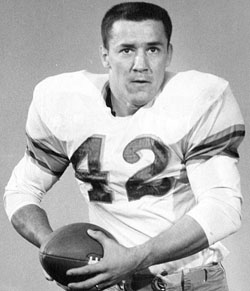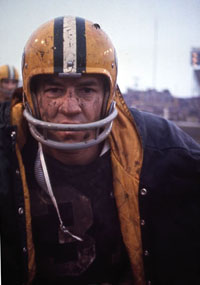LSU Short Story
Bud Johnson, Tiger Rag Extra, November 2018
|
Jim Taylor's crowd-pleasing running style won him a place in the Pro Football Hall of Fame and captivated fans throughout the National Football League. He was 83 when he passed away Oct. 13. Taylor was famous for attacking defenders. He didn't run away from tacklers. He ran at them. He would often change directions, lower his shoulder and run over a defensive back. His surprising strength and excellent balance enabled Jim to keep his feet and gain yardage after a collision. Taylor's game was special even for the NFL. Jim helped Vince Lombardi build a dynasty in Green Bay in the 1960s, playing on four NFL championship teams with the Packers. Green Bay won league championships in 1961, 1962, 1965, and 1966. Taylor was rewarded by being the first Packer from those great teams to be inducted into the Pro Football Hall of Fame in 1976. He was listed at 6 feet and 214 pounds. His achievements as an undersized, over-achieving fullback probably increased the NFL's use of strength and conditioning coaches. Taylor's efforts were surpassed by Jim Brown, the Cleveland Browns' great fullback, a bigger, faster runner. But Taylor by-passed Brown in 1962, ending the big back's five-year run as the No. 1 ball carrier in the NFL. Taylor ran for 1,474 yards that season. He was also first in rushing touchdowns with 19. He was voted MVP in the league and helped the Packers win the NFL championship. Taylor treasured that award and the memories of that special season. There was no better commercial for pro football in that period than the 1962 championship game. It was played in 40 mph winds, 13 degree temperatures on frozen turf in Yankee Stadium. It matched Green Bay's gritty ground game against the New York Giants great defense. Deception was for sissies. Taylor was the major offensive weapon for the Packers. Sam Huff was the primary assassin for the Giants defense. Taylor sustained a seven-inch gash on his elbow that required stitches at halftime. He bit his tongue so badly that he couldn't talk after the game. Huff pounded his prey from start to finish. But Jim answered with an unforgettable performance, gaining 85 yards in 31 carries and scoring the Packers' only offensive touchdown in the Packers' 16-7 victory. That game diminished the Jim Brown-Jim Taylor debate. It enhanced Taylor's reputation as one of pro football's toughest players. The game fueled television's love affair with professional football. |
  Jimmy Taylor |
Taylor was a 1,000 yard rusher in five consecutive seasons. He was elected to the NFL's all-decade team for the 1960s. He scored the first rushing touchdown in Super Bowl history. His 14-yard TD run in Super Bowl I came in the second quarter of the Packers' 35-10 victory over the Kansas City Chiefs of the AFL in January of 1967.
Jim got his start at Baton Rouge High, where he was a football and basketball star. Incredibly, he played in national high school all star games in both football and basketball — an unheard of accomplishment at the time.
"My favorite sport was basketball," Taylor once told this writer. "It helped me improve my balance and my stamina when I was younger. I became a better runner in football because of my balance."
Taylor wasn't a dominant football player for Baton Rouge High until his senior year. He was never a big talker. But in a close game he would assert himself when he deemed it necessary. When his Bulldogs needed a first down, Taylor would push aside sophomore signal caller Warren Rabb, and call his own number in the huddle. He made the high school All-America team and got a scholarship to LSU. His college career got off to a shaky start. In his freshman year of '54, Taylor was disciplined by none other than Gen. Troy H. Middleton, the university president, who suggested that Jim seek his education elsewhere. He spent 1955 at Hinds Community College in Mississippi and returned to LSU for the 1956 season. The Tigers started out 1-7 that year, and it looked like it might be the last for coach Paul Dietzel, who Taylor called "The Great White Father." But Taylor's late season heroics bought time for his coach. Jim played a major role in wins over Arkansas and Tulane. He gained 170 yards in a 21-7 win over the Razorbacks. The win over the Green Wave was even bigger. Tulane entered the game 6-1. They had defeated both Ole Miss and Mississippi State — teams that had thrashed the Tigers. Tulane led 6-0 at halftime. In the final 30 minutes, Taylor scored a touchdown, kicked the extra point to give LSU a 7-6 lead, and then made two big defensive plays to make sure the Tigers won. He caught Claude Mason from behind to save one touchdown and intercepted a pass on the LSU 8 to halt another Tulane threat.
As a senior in 1957, Taylor again played a major role in beating arch-rival Tulane. He made touchdown runs of 48 and 32 yards, which gave him 762 yards — best in the SEC — and 86 points — best in the nation. In his last game as a Tiger, he gained 171 yards in 17 tries. Performances like this one helped him to become a consensus All-American. Green Bay selected Taylor in the second round, but he didn't play much until Lombardi took over in 1959. Before joining the Packers, Taylor started a strength training program with Alvin Roy, who had trained the US weight lifting team in the 1952 Olympics. Weight lifting became the backbone of Taylor's workout regimen for the rest of his life.
Taylor's workout regime was legendary. He had no off season. He worked out every day, running and lifting weights. He was devoted to increasing his incredible strength and endurance. He wanted to be just as effective in the fourth quarter as he was in the first. He played nine seasons with thePackers, piling up 8,597 yards and scoring 83 touchdowns rushing. He signed as a free agent with the New Orleans Saints in 1967, his last season in the league. He was a Pro Bowl player from 1960 to 1964. Taylor played in an age when football professionals weren't millionaires. He never made more than $30,000 dollars for imitating a runaway freight train. He alone handled contract negations with Lombardi. He did a TV commercial for Coke that ran nationwide. It yielded Taylor only $3,500.
Although he played a game that was frequently violent, Jim's off-the-field life was the opposite. He was a sensitive, gentle man, who loved spending time with friends and family. He would console friends over a lost loved one.
You would never know that this was the same guy who played in those brutal 1960s duels with New York Giants linebacker Sam Huff. He didn't watch pro football much in his later years, although he rarely missed a Super Bowl. It was an opportunity to visit with his friends from his playing days.
Jim got his start at Baton Rouge High, where he was a football and basketball star. Incredibly, he played in national high school all star games in both football and basketball — an unheard of accomplishment at the time.
"My favorite sport was basketball," Taylor once told this writer. "It helped me improve my balance and my stamina when I was younger. I became a better runner in football because of my balance."
Taylor wasn't a dominant football player for Baton Rouge High until his senior year. He was never a big talker. But in a close game he would assert himself when he deemed it necessary. When his Bulldogs needed a first down, Taylor would push aside sophomore signal caller Warren Rabb, and call his own number in the huddle. He made the high school All-America team and got a scholarship to LSU. His college career got off to a shaky start. In his freshman year of '54, Taylor was disciplined by none other than Gen. Troy H. Middleton, the university president, who suggested that Jim seek his education elsewhere. He spent 1955 at Hinds Community College in Mississippi and returned to LSU for the 1956 season. The Tigers started out 1-7 that year, and it looked like it might be the last for coach Paul Dietzel, who Taylor called "The Great White Father." But Taylor's late season heroics bought time for his coach. Jim played a major role in wins over Arkansas and Tulane. He gained 170 yards in a 21-7 win over the Razorbacks. The win over the Green Wave was even bigger. Tulane entered the game 6-1. They had defeated both Ole Miss and Mississippi State — teams that had thrashed the Tigers. Tulane led 6-0 at halftime. In the final 30 minutes, Taylor scored a touchdown, kicked the extra point to give LSU a 7-6 lead, and then made two big defensive plays to make sure the Tigers won. He caught Claude Mason from behind to save one touchdown and intercepted a pass on the LSU 8 to halt another Tulane threat.
As a senior in 1957, Taylor again played a major role in beating arch-rival Tulane. He made touchdown runs of 48 and 32 yards, which gave him 762 yards — best in the SEC — and 86 points — best in the nation. In his last game as a Tiger, he gained 171 yards in 17 tries. Performances like this one helped him to become a consensus All-American. Green Bay selected Taylor in the second round, but he didn't play much until Lombardi took over in 1959. Before joining the Packers, Taylor started a strength training program with Alvin Roy, who had trained the US weight lifting team in the 1952 Olympics. Weight lifting became the backbone of Taylor's workout regimen for the rest of his life.
Taylor's workout regime was legendary. He had no off season. He worked out every day, running and lifting weights. He was devoted to increasing his incredible strength and endurance. He wanted to be just as effective in the fourth quarter as he was in the first. He played nine seasons with thePackers, piling up 8,597 yards and scoring 83 touchdowns rushing. He signed as a free agent with the New Orleans Saints in 1967, his last season in the league. He was a Pro Bowl player from 1960 to 1964. Taylor played in an age when football professionals weren't millionaires. He never made more than $30,000 dollars for imitating a runaway freight train. He alone handled contract negations with Lombardi. He did a TV commercial for Coke that ran nationwide. It yielded Taylor only $3,500.
Although he played a game that was frequently violent, Jim's off-the-field life was the opposite. He was a sensitive, gentle man, who loved spending time with friends and family. He would console friends over a lost loved one.
You would never know that this was the same guy who played in those brutal 1960s duels with New York Giants linebacker Sam Huff. He didn't watch pro football much in his later years, although he rarely missed a Super Bowl. It was an opportunity to visit with his friends from his playing days.